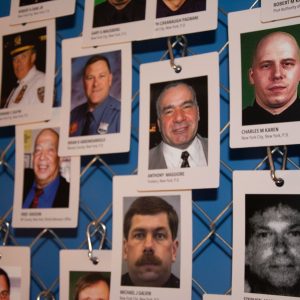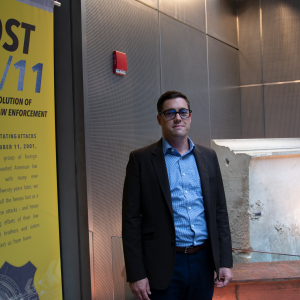WASHINGTON — The 72 law enforcement officers who were among the victims of the Sept. 11, 2001, terror attacks are being honored at a new, 2,000-square-foot exhibit at the National Law Enforcement Museum.
After recently reopening after being shuttered by the coronavirus pandemic, the museum has mounted a new addition: “Post 9/11: The Evolution of American Law Enforcement.”
In addition to the 72 who died in the attacks 20 years ago, the exhibit also recognizes an additional 300 officers who were on duty that day and have died over the years since then.
The exhibit aligns with the nonprofit’s mission to “tell the story of American law enforcement,” said Thomas Canavan, executive director of the museum.

“Even within just this exhibition, when you look at the role of Congress, and the Patriot Act, creating Homeland Security, and then moving through technology and innovation, community engagement, training and preparation and information sharing, you’ll start to realize the scope and the magnitude of keeping us all safe,” Canavan told Capital News Service.
The entrance to the DuPont Gallery is flanked with a 2,200-pound steel beam salvaged from one of the destroyed twin towers of New York’s World Trade Center and a 6,300-pound concrete block from the Pentagon.
A panel of academic and professional experts assembled virtually on Aug. 19, offering thoughtful last-minute contributions for curators ahead of the exhibit’s unveiling on Aug. 27.
“I think you can’t really understand the post-9/11 period unless you understand the trauma and the fear that the event created,” said David H. Schanzer, a Duke University professor at the Sanford School of Public Policy and director of the Triangle Center on Terrorism and Homeland Security.
Schanzer, with Michael Burns, a design director at Quatrefoil Associations, and Josh Feinberg, principal of JAF Consulting, started creating the exhibit’s educational content and physical fabrication — just a few months before the beginning of 2021 — ahead of the highly-anticipated anniversary.
Feinberg said he initially grappled with developing an exhibit meant to “memorialize and teach” at the same time without emotionally overwhelming visitors. He added that what was created is “not really an exhibit about 9/11” but rather an avenue to explore technological advancements within the profession of policing.

Law enforcement is facing numerous controversies, most notably multiple incidents in which people of color have died at the hands of police under questionable circumstances – and in some cases have led to prosecutions of officers. As a consequence, racial justice advocates and state and federal lawmakers have pressed for broad reforms in policing.
“Obviously, issues about law enforcement are in the public debate,” Feinberg admitted. “While we weren’t addressing those issues directly in the exhibition, there are certain resonances…”
Two of Canavan’s great-grandfathers and his wife’s great-grandfather were all police officers at one point. (Canavan holds an undergraduate degree in art from the University of Maryland and a master’s in arts administration from Boston University.)
Canavan said the museum is focused on bridging the divide between police and the communities they’re supposed to protect.
“I think at the end of the day, it’s about us helping bring law enforcement communities together and using this museum as a platform to teach the community more about law enforcement,” he said.
Editor’s Note: The National Law Enforcement Museum is open Fridays, Saturdays and Sundays and free admission is available to active and former law enforcement officers through Sept. 30. The exhibit is scheduled to run until July 31, 2022.


You must be logged in to post a comment.